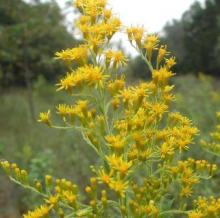
Solidago canadensis, S. virgaurea
The Goldenrod family, a subset of the Compositae or Aster family, is quite huge and diverse. There are many subspecies that are often very similar in appearance (and, thankfully, in medicinal qualities as well). We look for the flowering tops of plants blooming in late August and showing three prominent veins on a toothed leaf. The gold of this beautiful plant, so abundant in Vermont fields, is always a signal of coming frosts; it rarely requires cultivation, making a home of most soils it finds.
Elemental associations: Air
Phytochemistry: Flavonoids, tannins, saponins
Actions: Anti-catarrhal, antiseptic, diaphoretic, vulnerary
Specific systems: Respiratory, immune
Goldenrod is often blamed for seasonal allergies, because of its conspicuous blooms, but this is an unfortunate misconception that comes about only because it blooms at the same time as Ragweed (Ambrosia), a prime culprit in hayfever and allergies. In fact, we use Goldenrod to good effect in treating symptoms of catarrhal congestion, especially in the upper respiratory tract, whether they be as a result of allergies or simply a passing cold. Its diaphoretic power makes it even more effective in these latter conditions.
Loaded with bioflavonoids such as rutin and hesperidin, it is also helpful as an anti-inflammatory herb (part of the reason why it relieves allergic symptoms) and can be applied to wounds because of its antiseptic and mildly astringent qualities.
Indications: Upper respiratory congestion and catarrh, seasonal allergies (fall especially), wounds
Contraindications: None really.
Preparation/Dosage: To relieve acute symptoms of congestion, Goldenrod is best taken as a tea (3-4 TBS infused in a quart of hot water) thereby stimulating diaphoresis. For the more chronic complaint of allergic conditions, use the tincture prepared at 40%, 1:4, and taken at ¼ to ½ teaspoon doses at least twice a day (maybe more times during the worst of the pollen season).
